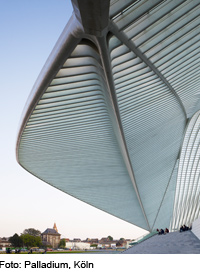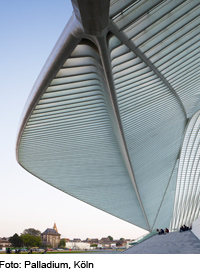Station in Liège

Liège is an important European railway node. Today, after a construction period of more than 12 years, the city possesses a modern station that not only meets the needs of highspeed trains, but that may be seen as a redefinition of the grand structures of the past. One aim of the planning was to accommodate all rolling stock within the station hall, with only extra long trains extending outside. In addition, an attempt was made with the new building to relink the urban districts of Cointé and Guillemins, which had long been divided by the railway line. For the 490-metre long station, an exceptionally large hall was designed, the roughly 160-metre-wide span of which is borne by structural arches laid outin a longitudinal direction, i.e. parallel to the tracks. As a result, the curved roof, with its broad cantilevered canopies, opens the station to the neighbouring urban districts, at the same time echoing the form of the nearby hills in Cointé. The station hall is also directly accessible from both sides. Since the hall has no facade, it is the roof that dominates the overall image. The transparent main structure consists of 39 steel arches at 1.90-metre centres. In view of the fact that the purlins are rigidly welded to every arch element, the entire structure functions like a shell load-bearing system. The hollow-steel sections of the arches taper towards the crest, where they are a mere 120 cm deep.
